Article Review: Managing Resistance to Change (BMO6624)
VerifiedAdded on 2023/01/12
|8
|3139
|56
Report
AI Summary
This report presents a detailed review of several articles focused on the critical aspects of organizational change management, specifically addressing the pervasive issue of resistance to change. The articles delve into the various facets of this resistance, exploring both its sources and potential mitigation strategies. One article examines the causes of resistance and emphasizes the importance of communication and employee involvement in the change process. Another article investigates the psychological factors contributing to resistance, such as defense mechanisms, and the need for a balanced approach to change management. A third article offers a taxonomical perspective, suggesting a framework for understanding resistance at individual, change program, and institutional levels. The final article discusses the challenges of inter-organizational projects and the need for proactive change practices. The review highlights the significance of understanding employee perspectives, utilizing effective communication, and adopting tailored approaches to manage resistance and facilitate successful organizational change. The report also includes a critique of each article, highlighting their strengths and weaknesses, and offering concluding remarks on the implications of each study's findings.
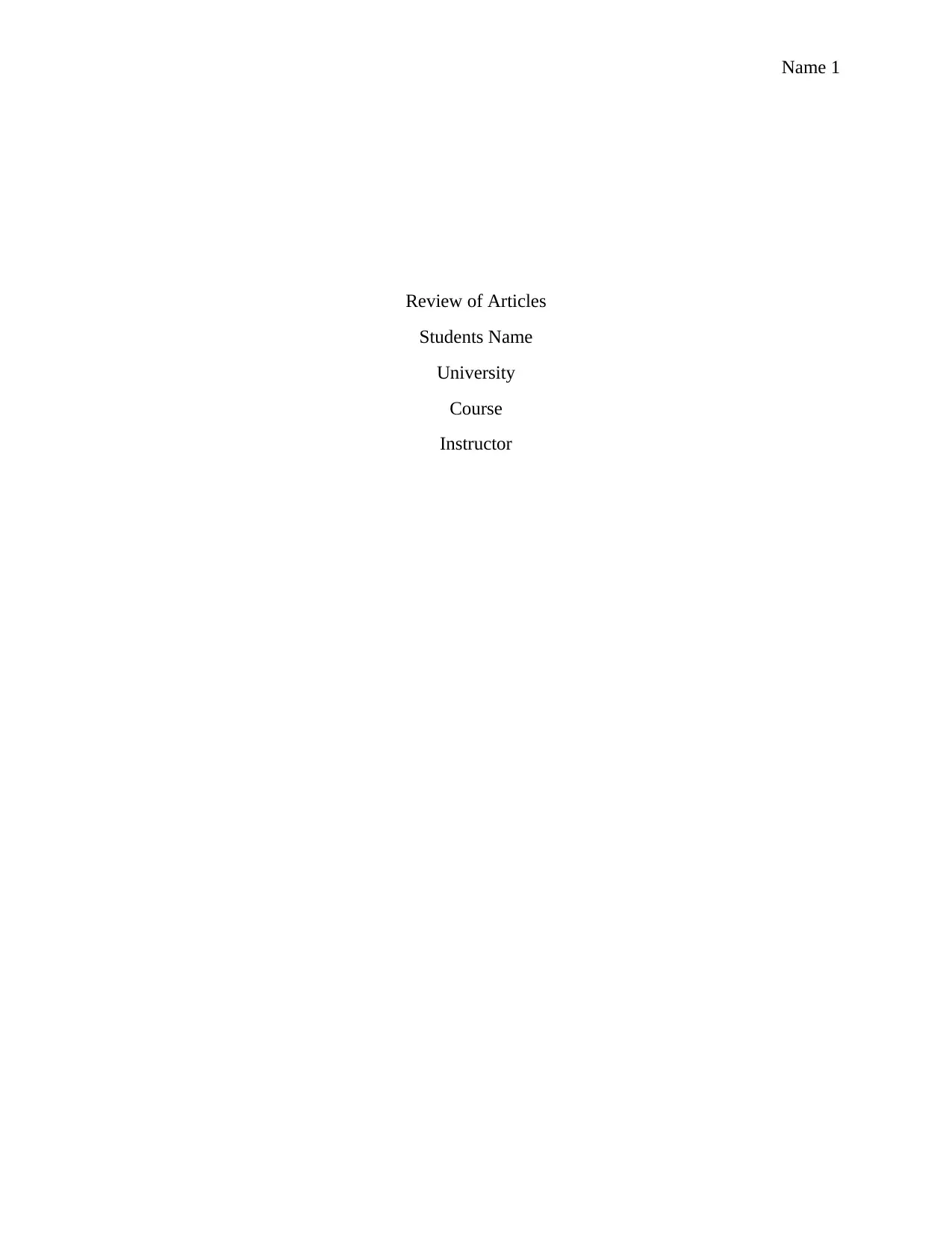
Name 1
Review of Articles
Students Name
University
Course
Instructor
Review of Articles
Students Name
University
Course
Instructor
Paraphrase This Document
Need a fresh take? Get an instant paraphrase of this document with our AI Paraphraser
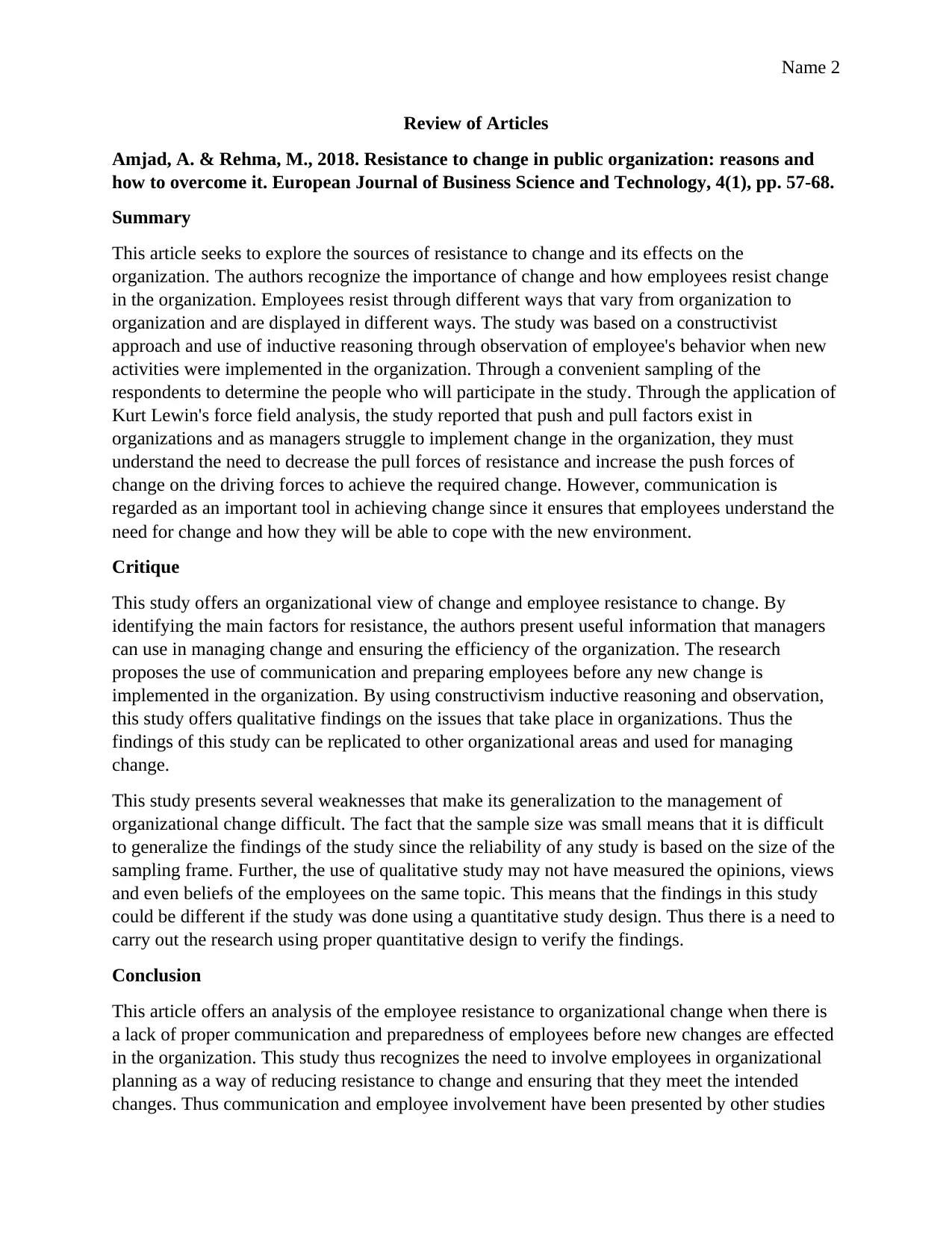
Name 2
Review of Articles
Amjad, A. & Rehma, M., 2018. Resistance to change in public organization: reasons and
how to overcome it. European Journal of Business Science and Technology, 4(1), pp. 57-68.
Summary
This article seeks to explore the sources of resistance to change and its effects on the
organization. The authors recognize the importance of change and how employees resist change
in the organization. Employees resist through different ways that vary from organization to
organization and are displayed in different ways. The study was based on a constructivist
approach and use of inductive reasoning through observation of employee's behavior when new
activities were implemented in the organization. Through a convenient sampling of the
respondents to determine the people who will participate in the study. Through the application of
Kurt Lewin's force field analysis, the study reported that push and pull factors exist in
organizations and as managers struggle to implement change in the organization, they must
understand the need to decrease the pull forces of resistance and increase the push forces of
change on the driving forces to achieve the required change. However, communication is
regarded as an important tool in achieving change since it ensures that employees understand the
need for change and how they will be able to cope with the new environment.
Critique
This study offers an organizational view of change and employee resistance to change. By
identifying the main factors for resistance, the authors present useful information that managers
can use in managing change and ensuring the efficiency of the organization. The research
proposes the use of communication and preparing employees before any new change is
implemented in the organization. By using constructivism inductive reasoning and observation,
this study offers qualitative findings on the issues that take place in organizations. Thus the
findings of this study can be replicated to other organizational areas and used for managing
change.
This study presents several weaknesses that make its generalization to the management of
organizational change difficult. The fact that the sample size was small means that it is difficult
to generalize the findings of the study since the reliability of any study is based on the size of the
sampling frame. Further, the use of qualitative study may not have measured the opinions, views
and even beliefs of the employees on the same topic. This means that the findings in this study
could be different if the study was done using a quantitative study design. Thus there is a need to
carry out the research using proper quantitative design to verify the findings.
Conclusion
This article offers an analysis of the employee resistance to organizational change when there is
a lack of proper communication and preparedness of employees before new changes are effected
in the organization. This study thus recognizes the need to involve employees in organizational
planning as a way of reducing resistance to change and ensuring that they meet the intended
changes. Thus communication and employee involvement have been presented by other studies
Review of Articles
Amjad, A. & Rehma, M., 2018. Resistance to change in public organization: reasons and
how to overcome it. European Journal of Business Science and Technology, 4(1), pp. 57-68.
Summary
This article seeks to explore the sources of resistance to change and its effects on the
organization. The authors recognize the importance of change and how employees resist change
in the organization. Employees resist through different ways that vary from organization to
organization and are displayed in different ways. The study was based on a constructivist
approach and use of inductive reasoning through observation of employee's behavior when new
activities were implemented in the organization. Through a convenient sampling of the
respondents to determine the people who will participate in the study. Through the application of
Kurt Lewin's force field analysis, the study reported that push and pull factors exist in
organizations and as managers struggle to implement change in the organization, they must
understand the need to decrease the pull forces of resistance and increase the push forces of
change on the driving forces to achieve the required change. However, communication is
regarded as an important tool in achieving change since it ensures that employees understand the
need for change and how they will be able to cope with the new environment.
Critique
This study offers an organizational view of change and employee resistance to change. By
identifying the main factors for resistance, the authors present useful information that managers
can use in managing change and ensuring the efficiency of the organization. The research
proposes the use of communication and preparing employees before any new change is
implemented in the organization. By using constructivism inductive reasoning and observation,
this study offers qualitative findings on the issues that take place in organizations. Thus the
findings of this study can be replicated to other organizational areas and used for managing
change.
This study presents several weaknesses that make its generalization to the management of
organizational change difficult. The fact that the sample size was small means that it is difficult
to generalize the findings of the study since the reliability of any study is based on the size of the
sampling frame. Further, the use of qualitative study may not have measured the opinions, views
and even beliefs of the employees on the same topic. This means that the findings in this study
could be different if the study was done using a quantitative study design. Thus there is a need to
carry out the research using proper quantitative design to verify the findings.
Conclusion
This article offers an analysis of the employee resistance to organizational change when there is
a lack of proper communication and preparedness of employees before new changes are effected
in the organization. This study thus recognizes the need to involve employees in organizational
planning as a way of reducing resistance to change and ensuring that they meet the intended
changes. Thus communication and employee involvement have been presented by other studies
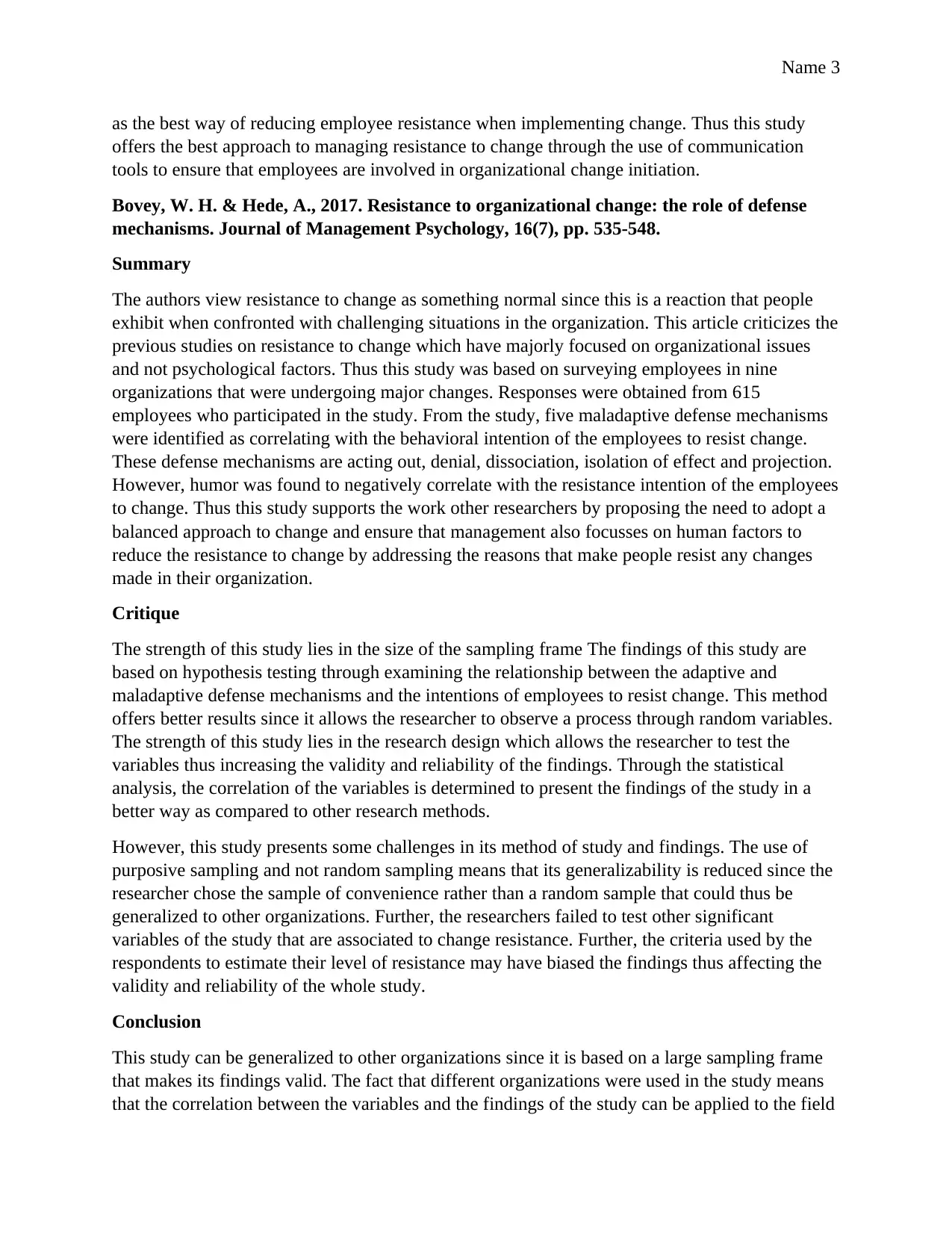
Name 3
as the best way of reducing employee resistance when implementing change. Thus this study
offers the best approach to managing resistance to change through the use of communication
tools to ensure that employees are involved in organizational change initiation.
Bovey, W. H. & Hede, A., 2017. Resistance to organizational change: the role of defense
mechanisms. Journal of Management Psychology, 16(7), pp. 535-548.
Summary
The authors view resistance to change as something normal since this is a reaction that people
exhibit when confronted with challenging situations in the organization. This article criticizes the
previous studies on resistance to change which have majorly focused on organizational issues
and not psychological factors. Thus this study was based on surveying employees in nine
organizations that were undergoing major changes. Responses were obtained from 615
employees who participated in the study. From the study, five maladaptive defense mechanisms
were identified as correlating with the behavioral intention of the employees to resist change.
These defense mechanisms are acting out, denial, dissociation, isolation of effect and projection.
However, humor was found to negatively correlate with the resistance intention of the employees
to change. Thus this study supports the work other researchers by proposing the need to adopt a
balanced approach to change and ensure that management also focusses on human factors to
reduce the resistance to change by addressing the reasons that make people resist any changes
made in their organization.
Critique
The strength of this study lies in the size of the sampling frame The findings of this study are
based on hypothesis testing through examining the relationship between the adaptive and
maladaptive defense mechanisms and the intentions of employees to resist change. This method
offers better results since it allows the researcher to observe a process through random variables.
The strength of this study lies in the research design which allows the researcher to test the
variables thus increasing the validity and reliability of the findings. Through the statistical
analysis, the correlation of the variables is determined to present the findings of the study in a
better way as compared to other research methods.
However, this study presents some challenges in its method of study and findings. The use of
purposive sampling and not random sampling means that its generalizability is reduced since the
researcher chose the sample of convenience rather than a random sample that could thus be
generalized to other organizations. Further, the researchers failed to test other significant
variables of the study that are associated to change resistance. Further, the criteria used by the
respondents to estimate their level of resistance may have biased the findings thus affecting the
validity and reliability of the whole study.
Conclusion
This study can be generalized to other organizations since it is based on a large sampling frame
that makes its findings valid. The fact that different organizations were used in the study means
that the correlation between the variables and the findings of the study can be applied to the field
as the best way of reducing employee resistance when implementing change. Thus this study
offers the best approach to managing resistance to change through the use of communication
tools to ensure that employees are involved in organizational change initiation.
Bovey, W. H. & Hede, A., 2017. Resistance to organizational change: the role of defense
mechanisms. Journal of Management Psychology, 16(7), pp. 535-548.
Summary
The authors view resistance to change as something normal since this is a reaction that people
exhibit when confronted with challenging situations in the organization. This article criticizes the
previous studies on resistance to change which have majorly focused on organizational issues
and not psychological factors. Thus this study was based on surveying employees in nine
organizations that were undergoing major changes. Responses were obtained from 615
employees who participated in the study. From the study, five maladaptive defense mechanisms
were identified as correlating with the behavioral intention of the employees to resist change.
These defense mechanisms are acting out, denial, dissociation, isolation of effect and projection.
However, humor was found to negatively correlate with the resistance intention of the employees
to change. Thus this study supports the work other researchers by proposing the need to adopt a
balanced approach to change and ensure that management also focusses on human factors to
reduce the resistance to change by addressing the reasons that make people resist any changes
made in their organization.
Critique
The strength of this study lies in the size of the sampling frame The findings of this study are
based on hypothesis testing through examining the relationship between the adaptive and
maladaptive defense mechanisms and the intentions of employees to resist change. This method
offers better results since it allows the researcher to observe a process through random variables.
The strength of this study lies in the research design which allows the researcher to test the
variables thus increasing the validity and reliability of the findings. Through the statistical
analysis, the correlation of the variables is determined to present the findings of the study in a
better way as compared to other research methods.
However, this study presents some challenges in its method of study and findings. The use of
purposive sampling and not random sampling means that its generalizability is reduced since the
researcher chose the sample of convenience rather than a random sample that could thus be
generalized to other organizations. Further, the researchers failed to test other significant
variables of the study that are associated to change resistance. Further, the criteria used by the
respondents to estimate their level of resistance may have biased the findings thus affecting the
validity and reliability of the whole study.
Conclusion
This study can be generalized to other organizations since it is based on a large sampling frame
that makes its findings valid. The fact that different organizations were used in the study means
that the correlation between the variables and the findings of the study can be applied to the field
⊘ This is a preview!⊘
Do you want full access?
Subscribe today to unlock all pages.

Trusted by 1+ million students worldwide
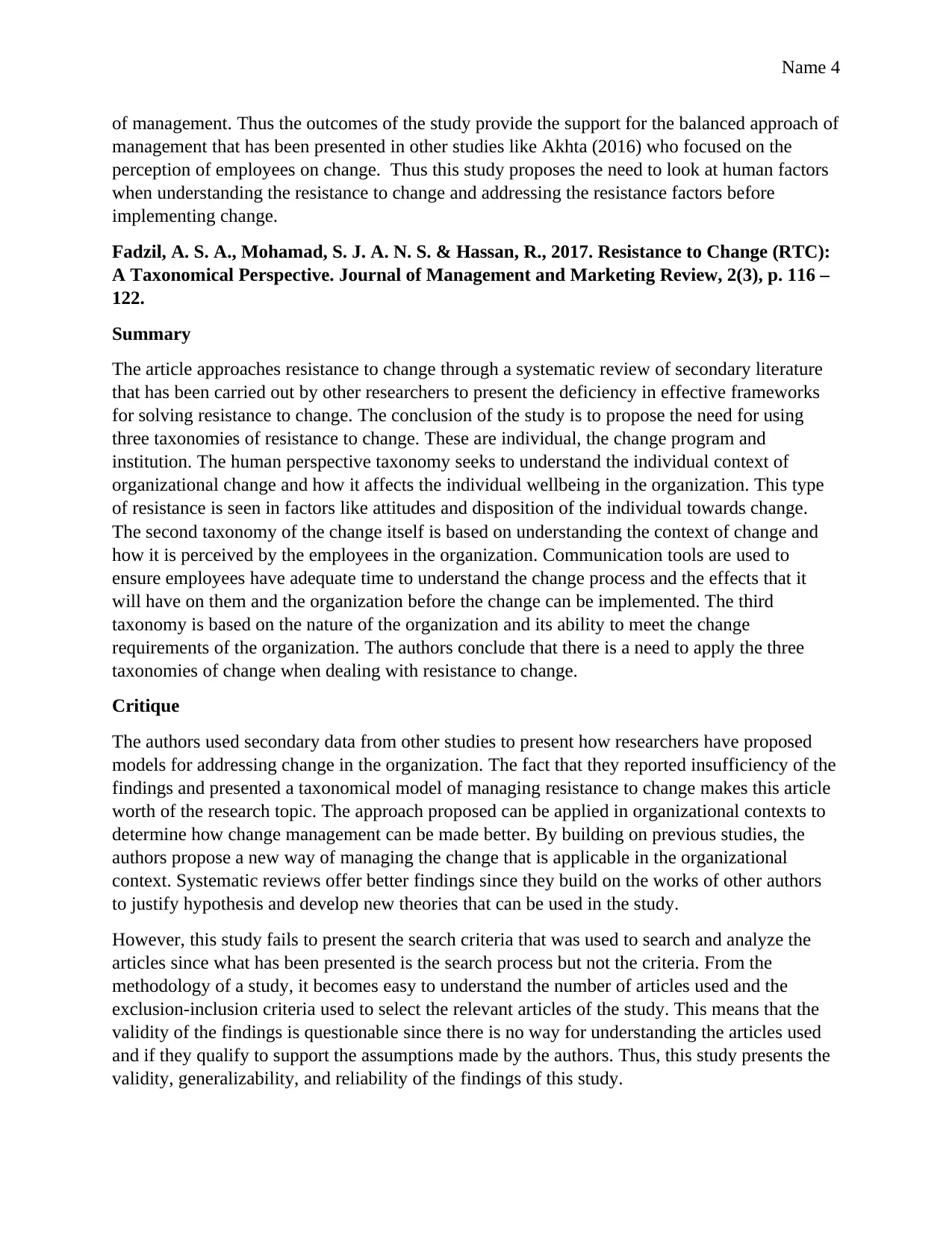
Name 4
of management. Thus the outcomes of the study provide the support for the balanced approach of
management that has been presented in other studies like Akhta (2016) who focused on the
perception of employees on change. Thus this study proposes the need to look at human factors
when understanding the resistance to change and addressing the resistance factors before
implementing change.
Fadzil, A. S. A., Mohamad, S. J. A. N. S. & Hassan, R., 2017. Resistance to Change (RTC):
A Taxonomical Perspective. Journal of Management and Marketing Review, 2(3), p. 116 –
122.
Summary
The article approaches resistance to change through a systematic review of secondary literature
that has been carried out by other researchers to present the deficiency in effective frameworks
for solving resistance to change. The conclusion of the study is to propose the need for using
three taxonomies of resistance to change. These are individual, the change program and
institution. The human perspective taxonomy seeks to understand the individual context of
organizational change and how it affects the individual wellbeing in the organization. This type
of resistance is seen in factors like attitudes and disposition of the individual towards change.
The second taxonomy of the change itself is based on understanding the context of change and
how it is perceived by the employees in the organization. Communication tools are used to
ensure employees have adequate time to understand the change process and the effects that it
will have on them and the organization before the change can be implemented. The third
taxonomy is based on the nature of the organization and its ability to meet the change
requirements of the organization. The authors conclude that there is a need to apply the three
taxonomies of change when dealing with resistance to change.
Critique
The authors used secondary data from other studies to present how researchers have proposed
models for addressing change in the organization. The fact that they reported insufficiency of the
findings and presented a taxonomical model of managing resistance to change makes this article
worth of the research topic. The approach proposed can be applied in organizational contexts to
determine how change management can be made better. By building on previous studies, the
authors propose a new way of managing the change that is applicable in the organizational
context. Systematic reviews offer better findings since they build on the works of other authors
to justify hypothesis and develop new theories that can be used in the study.
However, this study fails to present the search criteria that was used to search and analyze the
articles since what has been presented is the search process but not the criteria. From the
methodology of a study, it becomes easy to understand the number of articles used and the
exclusion-inclusion criteria used to select the relevant articles of the study. This means that the
validity of the findings is questionable since there is no way for understanding the articles used
and if they qualify to support the assumptions made by the authors. Thus, this study presents the
validity, generalizability, and reliability of the findings of this study.
of management. Thus the outcomes of the study provide the support for the balanced approach of
management that has been presented in other studies like Akhta (2016) who focused on the
perception of employees on change. Thus this study proposes the need to look at human factors
when understanding the resistance to change and addressing the resistance factors before
implementing change.
Fadzil, A. S. A., Mohamad, S. J. A. N. S. & Hassan, R., 2017. Resistance to Change (RTC):
A Taxonomical Perspective. Journal of Management and Marketing Review, 2(3), p. 116 –
122.
Summary
The article approaches resistance to change through a systematic review of secondary literature
that has been carried out by other researchers to present the deficiency in effective frameworks
for solving resistance to change. The conclusion of the study is to propose the need for using
three taxonomies of resistance to change. These are individual, the change program and
institution. The human perspective taxonomy seeks to understand the individual context of
organizational change and how it affects the individual wellbeing in the organization. This type
of resistance is seen in factors like attitudes and disposition of the individual towards change.
The second taxonomy of the change itself is based on understanding the context of change and
how it is perceived by the employees in the organization. Communication tools are used to
ensure employees have adequate time to understand the change process and the effects that it
will have on them and the organization before the change can be implemented. The third
taxonomy is based on the nature of the organization and its ability to meet the change
requirements of the organization. The authors conclude that there is a need to apply the three
taxonomies of change when dealing with resistance to change.
Critique
The authors used secondary data from other studies to present how researchers have proposed
models for addressing change in the organization. The fact that they reported insufficiency of the
findings and presented a taxonomical model of managing resistance to change makes this article
worth of the research topic. The approach proposed can be applied in organizational contexts to
determine how change management can be made better. By building on previous studies, the
authors propose a new way of managing the change that is applicable in the organizational
context. Systematic reviews offer better findings since they build on the works of other authors
to justify hypothesis and develop new theories that can be used in the study.
However, this study fails to present the search criteria that was used to search and analyze the
articles since what has been presented is the search process but not the criteria. From the
methodology of a study, it becomes easy to understand the number of articles used and the
exclusion-inclusion criteria used to select the relevant articles of the study. This means that the
validity of the findings is questionable since there is no way for understanding the articles used
and if they qualify to support the assumptions made by the authors. Thus, this study presents the
validity, generalizability, and reliability of the findings of this study.
Paraphrase This Document
Need a fresh take? Get an instant paraphrase of this document with our AI Paraphraser
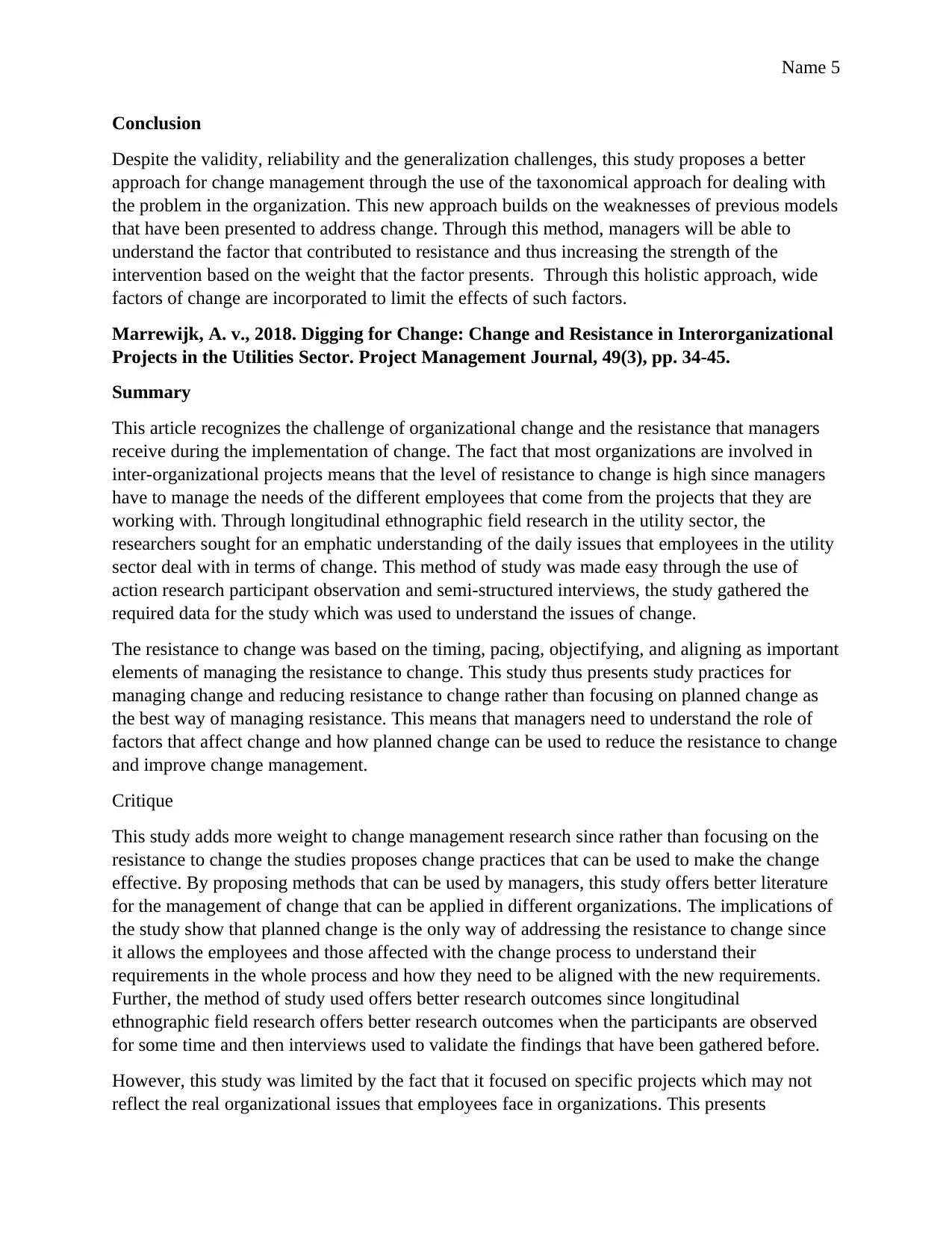
Name 5
Conclusion
Despite the validity, reliability and the generalization challenges, this study proposes a better
approach for change management through the use of the taxonomical approach for dealing with
the problem in the organization. This new approach builds on the weaknesses of previous models
that have been presented to address change. Through this method, managers will be able to
understand the factor that contributed to resistance and thus increasing the strength of the
intervention based on the weight that the factor presents. Through this holistic approach, wide
factors of change are incorporated to limit the effects of such factors.
Marrewijk, A. v., 2018. Digging for Change: Change and Resistance in Interorganizational
Projects in the Utilities Sector. Project Management Journal, 49(3), pp. 34-45.
Summary
This article recognizes the challenge of organizational change and the resistance that managers
receive during the implementation of change. The fact that most organizations are involved in
inter-organizational projects means that the level of resistance to change is high since managers
have to manage the needs of the different employees that come from the projects that they are
working with. Through longitudinal ethnographic field research in the utility sector, the
researchers sought for an emphatic understanding of the daily issues that employees in the utility
sector deal with in terms of change. This method of study was made easy through the use of
action research participant observation and semi-structured interviews, the study gathered the
required data for the study which was used to understand the issues of change.
The resistance to change was based on the timing, pacing, objectifying, and aligning as important
elements of managing the resistance to change. This study thus presents study practices for
managing change and reducing resistance to change rather than focusing on planned change as
the best way of managing resistance. This means that managers need to understand the role of
factors that affect change and how planned change can be used to reduce the resistance to change
and improve change management.
Critique
This study adds more weight to change management research since rather than focusing on the
resistance to change the studies proposes change practices that can be used to make the change
effective. By proposing methods that can be used by managers, this study offers better literature
for the management of change that can be applied in different organizations. The implications of
the study show that planned change is the only way of addressing the resistance to change since
it allows the employees and those affected with the change process to understand their
requirements in the whole process and how they need to be aligned with the new requirements.
Further, the method of study used offers better research outcomes since longitudinal
ethnographic field research offers better research outcomes when the participants are observed
for some time and then interviews used to validate the findings that have been gathered before.
However, this study was limited by the fact that it focused on specific projects which may not
reflect the real organizational issues that employees face in organizations. This presents
Conclusion
Despite the validity, reliability and the generalization challenges, this study proposes a better
approach for change management through the use of the taxonomical approach for dealing with
the problem in the organization. This new approach builds on the weaknesses of previous models
that have been presented to address change. Through this method, managers will be able to
understand the factor that contributed to resistance and thus increasing the strength of the
intervention based on the weight that the factor presents. Through this holistic approach, wide
factors of change are incorporated to limit the effects of such factors.
Marrewijk, A. v., 2018. Digging for Change: Change and Resistance in Interorganizational
Projects in the Utilities Sector. Project Management Journal, 49(3), pp. 34-45.
Summary
This article recognizes the challenge of organizational change and the resistance that managers
receive during the implementation of change. The fact that most organizations are involved in
inter-organizational projects means that the level of resistance to change is high since managers
have to manage the needs of the different employees that come from the projects that they are
working with. Through longitudinal ethnographic field research in the utility sector, the
researchers sought for an emphatic understanding of the daily issues that employees in the utility
sector deal with in terms of change. This method of study was made easy through the use of
action research participant observation and semi-structured interviews, the study gathered the
required data for the study which was used to understand the issues of change.
The resistance to change was based on the timing, pacing, objectifying, and aligning as important
elements of managing the resistance to change. This study thus presents study practices for
managing change and reducing resistance to change rather than focusing on planned change as
the best way of managing resistance. This means that managers need to understand the role of
factors that affect change and how planned change can be used to reduce the resistance to change
and improve change management.
Critique
This study adds more weight to change management research since rather than focusing on the
resistance to change the studies proposes change practices that can be used to make the change
effective. By proposing methods that can be used by managers, this study offers better literature
for the management of change that can be applied in different organizations. The implications of
the study show that planned change is the only way of addressing the resistance to change since
it allows the employees and those affected with the change process to understand their
requirements in the whole process and how they need to be aligned with the new requirements.
Further, the method of study used offers better research outcomes since longitudinal
ethnographic field research offers better research outcomes when the participants are observed
for some time and then interviews used to validate the findings that have been gathered before.
However, this study was limited by the fact that it focused on specific projects which may not
reflect the real organizational issues that employees face in organizations. This presents
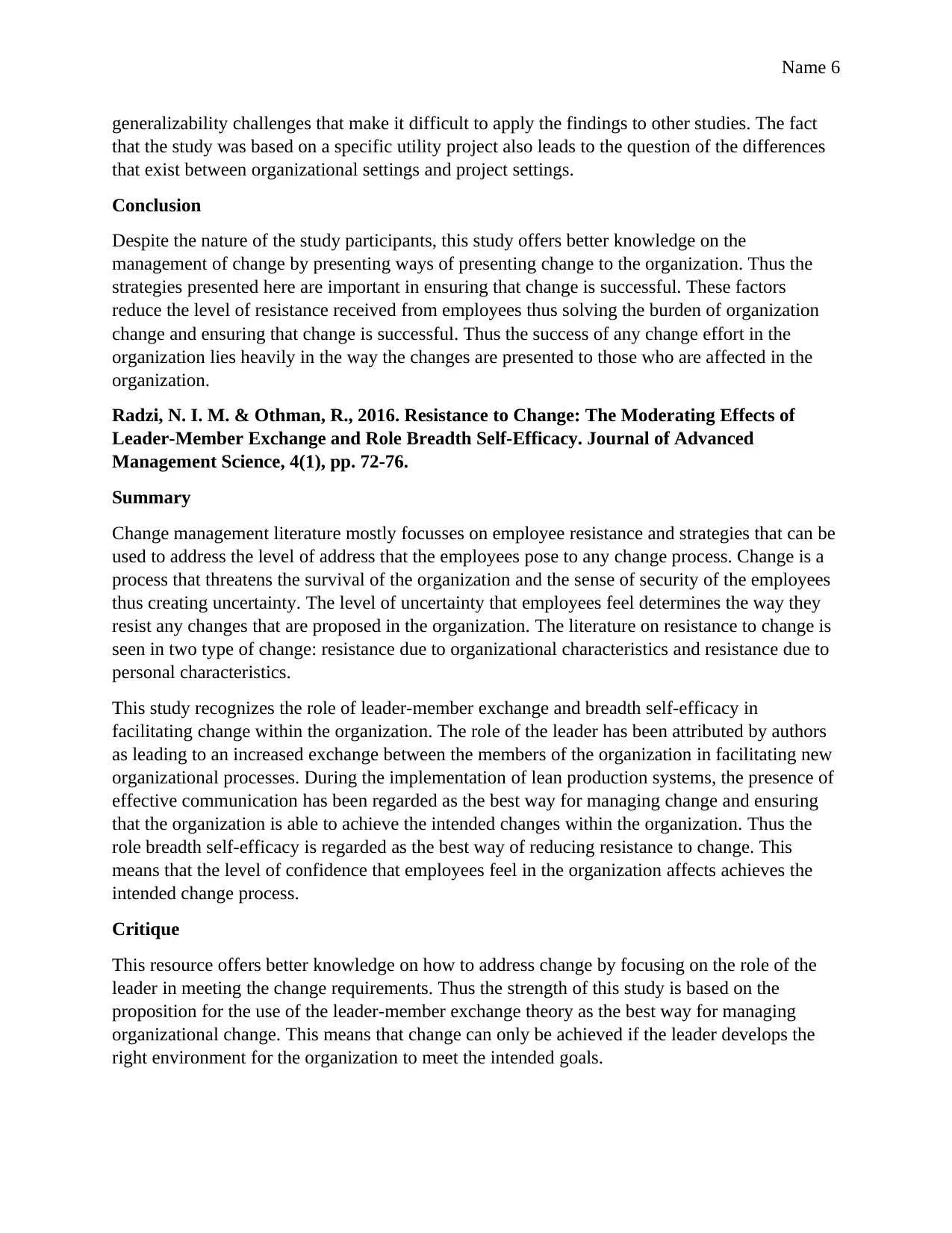
Name 6
generalizability challenges that make it difficult to apply the findings to other studies. The fact
that the study was based on a specific utility project also leads to the question of the differences
that exist between organizational settings and project settings.
Conclusion
Despite the nature of the study participants, this study offers better knowledge on the
management of change by presenting ways of presenting change to the organization. Thus the
strategies presented here are important in ensuring that change is successful. These factors
reduce the level of resistance received from employees thus solving the burden of organization
change and ensuring that change is successful. Thus the success of any change effort in the
organization lies heavily in the way the changes are presented to those who are affected in the
organization.
Radzi, N. I. M. & Othman, R., 2016. Resistance to Change: The Moderating Effects of
Leader-Member Exchange and Role Breadth Self-Efficacy. Journal of Advanced
Management Science, 4(1), pp. 72-76.
Summary
Change management literature mostly focusses on employee resistance and strategies that can be
used to address the level of address that the employees pose to any change process. Change is a
process that threatens the survival of the organization and the sense of security of the employees
thus creating uncertainty. The level of uncertainty that employees feel determines the way they
resist any changes that are proposed in the organization. The literature on resistance to change is
seen in two type of change: resistance due to organizational characteristics and resistance due to
personal characteristics.
This study recognizes the role of leader-member exchange and breadth self-efficacy in
facilitating change within the organization. The role of the leader has been attributed by authors
as leading to an increased exchange between the members of the organization in facilitating new
organizational processes. During the implementation of lean production systems, the presence of
effective communication has been regarded as the best way for managing change and ensuring
that the organization is able to achieve the intended changes within the organization. Thus the
role breadth self-efficacy is regarded as the best way of reducing resistance to change. This
means that the level of confidence that employees feel in the organization affects achieves the
intended change process.
Critique
This resource offers better knowledge on how to address change by focusing on the role of the
leader in meeting the change requirements. Thus the strength of this study is based on the
proposition for the use of the leader-member exchange theory as the best way for managing
organizational change. This means that change can only be achieved if the leader develops the
right environment for the organization to meet the intended goals.
generalizability challenges that make it difficult to apply the findings to other studies. The fact
that the study was based on a specific utility project also leads to the question of the differences
that exist between organizational settings and project settings.
Conclusion
Despite the nature of the study participants, this study offers better knowledge on the
management of change by presenting ways of presenting change to the organization. Thus the
strategies presented here are important in ensuring that change is successful. These factors
reduce the level of resistance received from employees thus solving the burden of organization
change and ensuring that change is successful. Thus the success of any change effort in the
organization lies heavily in the way the changes are presented to those who are affected in the
organization.
Radzi, N. I. M. & Othman, R., 2016. Resistance to Change: The Moderating Effects of
Leader-Member Exchange and Role Breadth Self-Efficacy. Journal of Advanced
Management Science, 4(1), pp. 72-76.
Summary
Change management literature mostly focusses on employee resistance and strategies that can be
used to address the level of address that the employees pose to any change process. Change is a
process that threatens the survival of the organization and the sense of security of the employees
thus creating uncertainty. The level of uncertainty that employees feel determines the way they
resist any changes that are proposed in the organization. The literature on resistance to change is
seen in two type of change: resistance due to organizational characteristics and resistance due to
personal characteristics.
This study recognizes the role of leader-member exchange and breadth self-efficacy in
facilitating change within the organization. The role of the leader has been attributed by authors
as leading to an increased exchange between the members of the organization in facilitating new
organizational processes. During the implementation of lean production systems, the presence of
effective communication has been regarded as the best way for managing change and ensuring
that the organization is able to achieve the intended changes within the organization. Thus the
role breadth self-efficacy is regarded as the best way of reducing resistance to change. This
means that the level of confidence that employees feel in the organization affects achieves the
intended change process.
Critique
This resource offers better knowledge on how to address change by focusing on the role of the
leader in meeting the change requirements. Thus the strength of this study is based on the
proposition for the use of the leader-member exchange theory as the best way for managing
organizational change. This means that change can only be achieved if the leader develops the
right environment for the organization to meet the intended goals.
⊘ This is a preview!⊘
Do you want full access?
Subscribe today to unlock all pages.

Trusted by 1+ million students worldwide
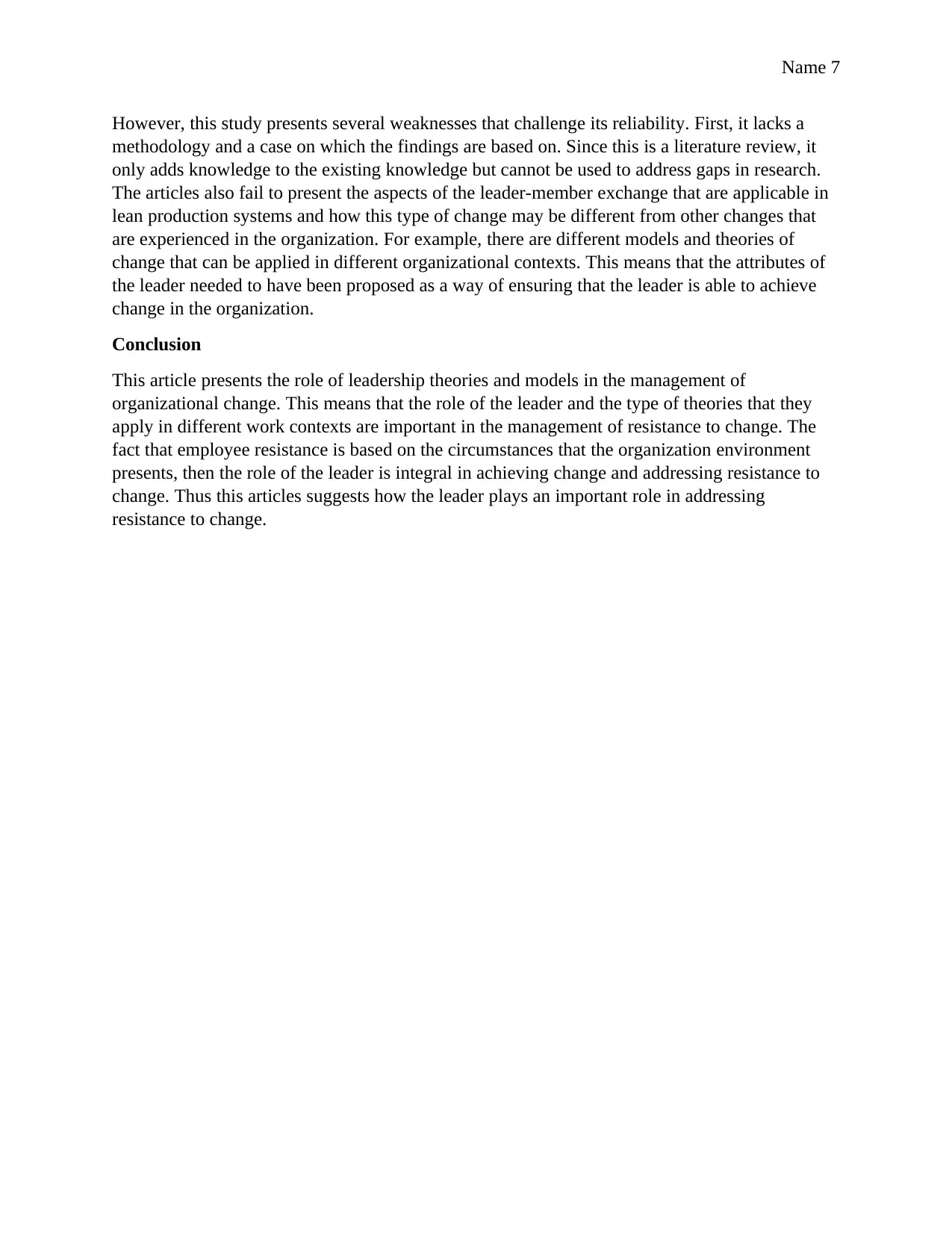
Name 7
However, this study presents several weaknesses that challenge its reliability. First, it lacks a
methodology and a case on which the findings are based on. Since this is a literature review, it
only adds knowledge to the existing knowledge but cannot be used to address gaps in research.
The articles also fail to present the aspects of the leader-member exchange that are applicable in
lean production systems and how this type of change may be different from other changes that
are experienced in the organization. For example, there are different models and theories of
change that can be applied in different organizational contexts. This means that the attributes of
the leader needed to have been proposed as a way of ensuring that the leader is able to achieve
change in the organization.
Conclusion
This article presents the role of leadership theories and models in the management of
organizational change. This means that the role of the leader and the type of theories that they
apply in different work contexts are important in the management of resistance to change. The
fact that employee resistance is based on the circumstances that the organization environment
presents, then the role of the leader is integral in achieving change and addressing resistance to
change. Thus this articles suggests how the leader plays an important role in addressing
resistance to change.
However, this study presents several weaknesses that challenge its reliability. First, it lacks a
methodology and a case on which the findings are based on. Since this is a literature review, it
only adds knowledge to the existing knowledge but cannot be used to address gaps in research.
The articles also fail to present the aspects of the leader-member exchange that are applicable in
lean production systems and how this type of change may be different from other changes that
are experienced in the organization. For example, there are different models and theories of
change that can be applied in different organizational contexts. This means that the attributes of
the leader needed to have been proposed as a way of ensuring that the leader is able to achieve
change in the organization.
Conclusion
This article presents the role of leadership theories and models in the management of
organizational change. This means that the role of the leader and the type of theories that they
apply in different work contexts are important in the management of resistance to change. The
fact that employee resistance is based on the circumstances that the organization environment
presents, then the role of the leader is integral in achieving change and addressing resistance to
change. Thus this articles suggests how the leader plays an important role in addressing
resistance to change.
Paraphrase This Document
Need a fresh take? Get an instant paraphrase of this document with our AI Paraphraser
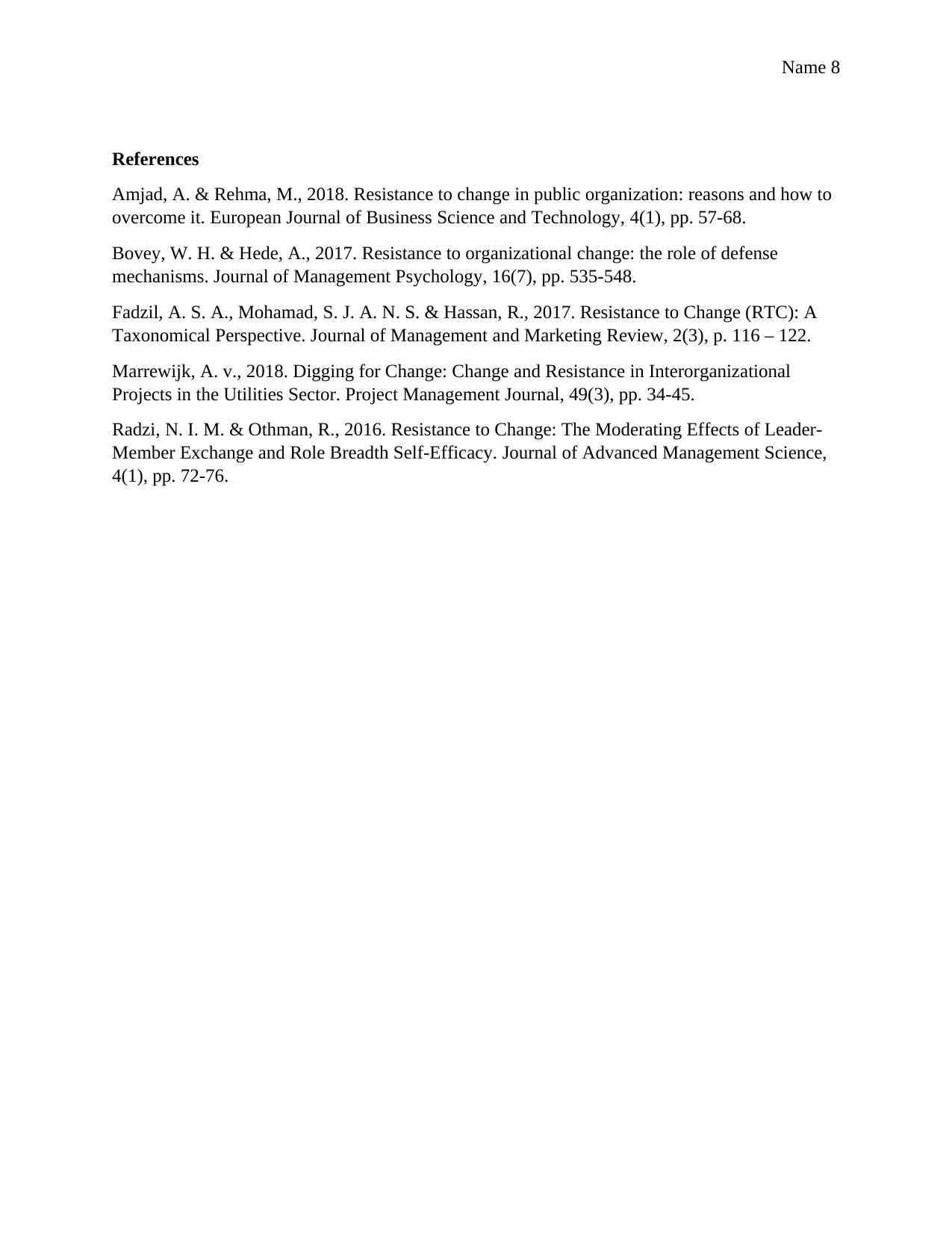
Name 8
References
Amjad, A. & Rehma, M., 2018. Resistance to change in public organization: reasons and how to
overcome it. European Journal of Business Science and Technology, 4(1), pp. 57-68.
Bovey, W. H. & Hede, A., 2017. Resistance to organizational change: the role of defense
mechanisms. Journal of Management Psychology, 16(7), pp. 535-548.
Fadzil, A. S. A., Mohamad, S. J. A. N. S. & Hassan, R., 2017. Resistance to Change (RTC): A
Taxonomical Perspective. Journal of Management and Marketing Review, 2(3), p. 116 – 122.
Marrewijk, A. v., 2018. Digging for Change: Change and Resistance in Interorganizational
Projects in the Utilities Sector. Project Management Journal, 49(3), pp. 34-45.
Radzi, N. I. M. & Othman, R., 2016. Resistance to Change: The Moderating Effects of Leader-
Member Exchange and Role Breadth Self-Efficacy. Journal of Advanced Management Science,
4(1), pp. 72-76.
References
Amjad, A. & Rehma, M., 2018. Resistance to change in public organization: reasons and how to
overcome it. European Journal of Business Science and Technology, 4(1), pp. 57-68.
Bovey, W. H. & Hede, A., 2017. Resistance to organizational change: the role of defense
mechanisms. Journal of Management Psychology, 16(7), pp. 535-548.
Fadzil, A. S. A., Mohamad, S. J. A. N. S. & Hassan, R., 2017. Resistance to Change (RTC): A
Taxonomical Perspective. Journal of Management and Marketing Review, 2(3), p. 116 – 122.
Marrewijk, A. v., 2018. Digging for Change: Change and Resistance in Interorganizational
Projects in the Utilities Sector. Project Management Journal, 49(3), pp. 34-45.
Radzi, N. I. M. & Othman, R., 2016. Resistance to Change: The Moderating Effects of Leader-
Member Exchange and Role Breadth Self-Efficacy. Journal of Advanced Management Science,
4(1), pp. 72-76.
1 out of 8
Related Documents
Your All-in-One AI-Powered Toolkit for Academic Success.
+13062052269
info@desklib.com
Available 24*7 on WhatsApp / Email
![[object Object]](/_next/static/media/star-bottom.7253800d.svg)
Unlock your academic potential
Copyright © 2020–2025 A2Z Services. All Rights Reserved. Developed and managed by ZUCOL.




